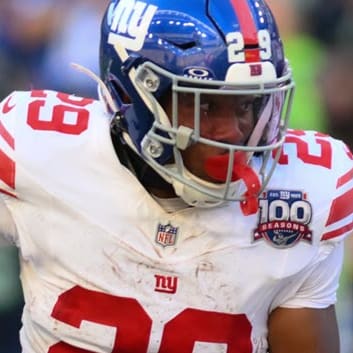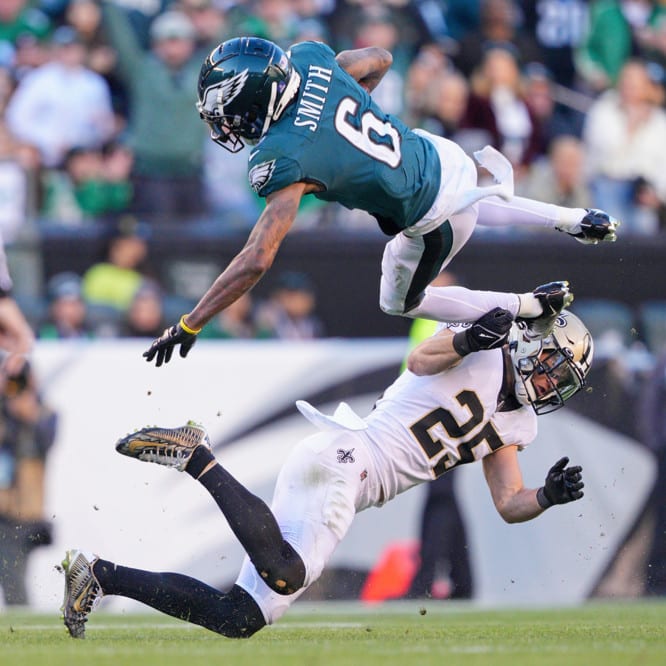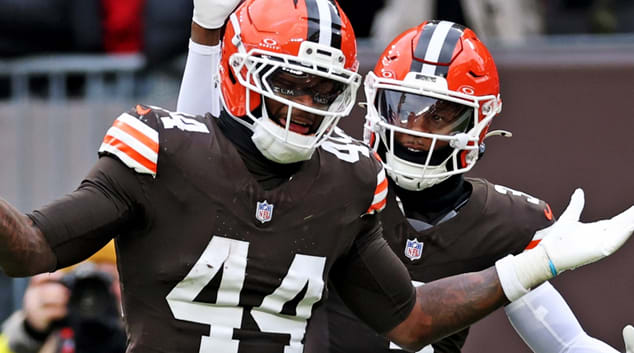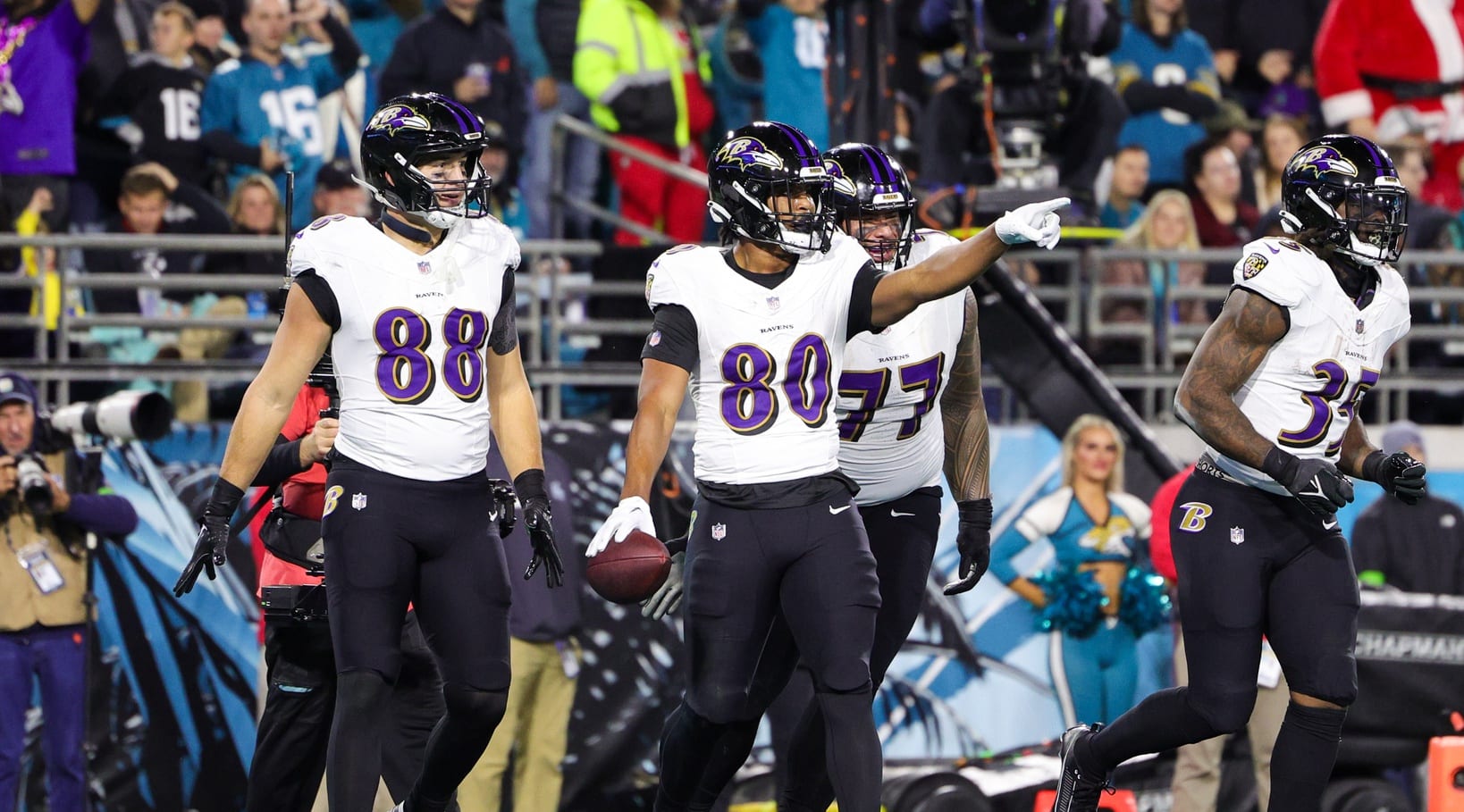RotoWire's 2024 NFL projections are LIVE, featuring 524 offensive players (QB/RB/WR/TE) plus 41 kickers and all 32 team defenses. That includes every rookie projected as a Day 1 or 2 draft pick and a lot of the guys who figure to be Day 3 picks or priority UDFAs. We also have 2024 rankings that are generated from those projections.
The numbers will, of course, change a lot between now and Week 1, especially in mid-to-late March (free agency) and at the end of April (NFL Draft). Running backs are particularly prone to moving way up or down, at least once we get past the top 10-to-15 guys. That's even more true than usual this year with a handful of big-name RBs — Saquon Barkley, Josh Jacobs, Derrick Henry, Austin Ekeler, D'Andre Swift — eligible for unrestricted free agency in March.
Even the RBs under contract can be tricky. Joe Mixon, for example, could easily do the same thing he did the past two years, or he could be replaced and fade to irrelevance. Not that we'll have a definitive answer there by summer, but we'll at least have a better clue once we've seen what the Bengals do this offseason.
After doing the heavy lifting for RW's initial 2024 projections these past few weeks, there are a few things I learned and would like to share, ranging from stray observations about individual players to assessments of positional strength/tiers. If you've got any thoughts, concerns,
RotoWire's 2024 NFL projections are LIVE, featuring 524 offensive players (QB/RB/WR/TE) plus 41 kickers and all 32 team defenses. That includes every rookie projected as a Day 1 or 2 draft pick and a lot of the guys who figure to be Day 3 picks or priority UDFAs. We also have 2024 rankings that are generated from those projections.
The numbers will, of course, change a lot between now and Week 1, especially in mid-to-late March (free agency) and at the end of April (NFL Draft). Running backs are particularly prone to moving way up or down, at least once we get past the top 10-to-15 guys. That's even more true than usual this year with a handful of big-name RBs — Saquon Barkley, Josh Jacobs, Derrick Henry, Austin Ekeler, D'Andre Swift — eligible for unrestricted free agency in March.
Even the RBs under contract can be tricky. Joe Mixon, for example, could easily do the same thing he did the past two years, or he could be replaced and fade to irrelevance. Not that we'll have a definitive answer there by summer, but we'll at least have a better clue once we've seen what the Bengals do this offseason.
After doing the heavy lifting for RW's initial 2024 projections these past few weeks, there are a few things I learned and would like to share, ranging from stray observations about individual players to assessments of positional strength/tiers. If you've got any thoughts, concerns, criticism, etc., I'd be more than happy to chat in the comments at the bottom of this article. I should also mention that you can export our projections into a spreadsheet and then do your own custom fantasy rankings.
Really, though, projections are just a tool to create fantasy rankings at this early stage of the offseason. Even assigning stats at a team level entails a lot of guesswork, not to mention the difficulty of not knowing which players will be on which teams. The numbers we have this summer — after the draft, when rosters are mostly settled — will come from a more mathematical, precise process. Still, I'm proud of what we've got now.
If you're playing best ball or making dynasty trades, I'd definitely recommend peeping RW's rankings/projections or using the RotoWire fantasy draft assistant. Fantasy football ADP from best ball sites is another good tool, and I've already started writing articles based on the early numbers coming out. Our projections were completed before I looked at any ADP numbers, but I do believe in the wisdom of the crowd (to some extent) and accordingly made edits to a few players whose RW projections were way out of whack with ADP, or even with fantasy football auction values.
For others, like Travis Kelce and Aaron Jones, I stuck to my guns / couldn't find the statistical argument for projecting them as low as they're being drafted. In Kelce's case, concern about retirement might be pushing him down to Round 4/5 in early best balls, and that's obviously not something I'm projecting (especially when he's dating Taylor Swift and doesn't have a spotlight outside of the gridiron!).
Even with the benefit of nepotism, Kelce isn't going to get a job as a backup dancer on the Eras Tour. And if you've ever heard him speak, well yeah, he's probably not getting a job in a broadcast booth either (though his brother might).
Anyway, here are some of my favorite observations for the first run of projections ...
Josh Allen = QB1
This doesn't mean he's guaranteed to finish as QB1 overall; in fact, I'd take the field against him even though Allen was No. 1 three of the last four seasons (and came pretty close in 2022). There's something that makes me a bit nervous about the Bills in general. WR Stefon Diggs isn't sure what his future holds after a slow finish to 2023, the team's cap situation is the worst it's been in years, and the Bills have done a good job developing complementary players but don't really have stars beyond Allen, Diggs and two 29-year-old defenders coming back from major injuries (CB Tre'Davious White - Achilles, LB Matt Milano - broken leg).
Still, when I messed around with projections, there was nothing I could reasonably do that even came close to getting Allen out of the top spot at QB. Projecting the Bills offense for more decline than I actually expected didn't do the trick. Regressing his rushing TDs more than I expected also didn't work (he's never had fewer than six in a season, and many of the rushing scores you take away from him simply become Allen passing TDs anyway). I probably won't be drafting Allen before the third round — which means I won't have many shares — but my projections still have him as the easy QB1.
Projections Flatten After Round 1
Every year comes with drop-offs and tiers at different places. For me, the first big gap is between RB Christian McCaffrey and the top-5 WRs (Tyreek Hill, Justin Jefferson, CeeDee Lamb, Ja'Marr Chase, Amon-Ra St. Brown). I also view RB Breece Hall as a strong first-round pick, and WR Puka Nacua slightly less so. That brings us to eight players
Picking closer to the turn, I also see some guys that stand out ... Bijan Robinson, Jonathan Taylor, Kyren Williams, Garrett Wilson, A.J. Brown. Most would put Jahmyr Gibbs in that group, but I don't.
After that, I don't see a huge gap between the next 25 guys or so (until we get into the 40s). You might think that guys like Nico Collins (No. 13), Travis Etienne (No. 19) and Travis Kelce (No. 23) are projected/ranked too high. And you might be right, or not, but I'd caution that if you look at the numbers there's really not much of a difference between them and the guys 20 spots behind them.
For me, that's quite different from last year, when I thought there was a pretty big drop after the 2-3 turn. Naturally, it didn't play out that way during the 2023 season. Most of the guys commonly drafted at the 2-3 turn ended up disappointing (Patrick Mahomes, Calvin Ridley, DeVonta Smith, Josh Jacobs, Tee Higgins), and some of the guys with ADPs in the 30s ended up having big years (Gibbs, Keenan Allen, DJ Moore, Travis Etienne).
It's good to keep track of this stuff, especially if you play in a league that allows pick trading, but I wouldn't worry about it too much. Stuff that happens in March and April likely will separate some of the guys from the others, and/or we'll see groupthink / ADP piggy-backing lead to perceptions of certain tiers.
This last point is something I'll return to in best-ball-strategy articles later this offseason, particularly when I discuss building unique teams in tournaments. I don't love "reaching" for guys well ahead of ADP, but it makes more sense if there's not much difference between Nos. 15 and No. 40 in my rankings and I'm hoping to build unique rosters (e.g. few teams will roster more than two guys with Round 4 ADPs, but you could feasibly draft four without sacrificing too much value if you pick McCaffrey first overall and then take Round-4-ADP players at 24, 25, 48 and 49).
Older Guys Players Are Tricky to Project/Figure
I'd generally recommend drafting older players (late 20s and 30s) a bit later than where they're ranked based strictly on projections. The main reason for that is heightened risk of falling off a cliff in any given season, which is hard to project. Some players decline slowly, others simply lose it one year and never get it back. We don't really know which type a guy will be until it's too late to matter.
Then we have false declines like Mike Evans in 2022. He topped 1,000 yards for a ninth consecutive year, but most of us nonetheless saw it as the start of his downfall due to his age, slight drop in YPT/catch rate, lack of TDs (six) and middling target share (19.8 percent in active games).
I dropped Evans in my 2023 rankings relative to past years, but not as far as others did, which meant I ended up with a ton of shares (probably more than I wanted). It ended up being one of my most profitable stances of the year, though even now it's easy to see how it could've worked out the other way.
What did I see? Well, one thing I definitely didn't see was Baker Mayfield being better than league-average in basically every passing efficiency stat (TD rate, INT rate, completion percentage, YPA, NY/A). But I did consider the possibility that Mayfield might be better for Evans than 2022 Tom Brady had been, even if I didn't expect Mayfield to be better overall.
Brady always loved throwing to RBs, and reduced arm strength at the end of his career reasonably might have hurt Evans more than the team's other pass catchers. On top of that, Evans still passed the eye test in 2022, notably exploding for 10-207-3 in Week 17 against Carolina.
Then, in 2023, his target share rebounded to 24.7 percent while catching passes from Mayfield. The 13 TDs involved an element of luck, perhaps, but Evans would've been a good pick at ADP even with only six or seven scores and the same number of catches/yards (79 for 1,255).
Looking at 2023, there are a few older players that declined statistically but might actually rebound rather than dipping again in 2024. RB Derrick Henry and WR DeAndre Hopkins are the first two that come to mind. Both still passed the eye test in 2023, and they were stuck in an offense with poor QB play and blocking.
On top of that, Hopkins' aDOT spiked to 14.1, following five consecutive years in the range of 8.9 to 12.3. He averaged 4.4 catches for 62.2 yards per game, down from 7.1 for 79.7 in his suspension-shortened, QB-injury-impacted 2022 with Arizona. The way I see it, Hopkins is now an "anything could happen" guy. He's scheduled for $16 million in non-guaranteed compensation in 2024, the final year of his contract.
One possibility is signing with a team that puts him back in a higher-volume, lower-aDOT role and allows him to push for 100 catches. Another possibility, unfortunately, is that the 32-year-old is simply cooked. When doing projections, I can't just pick one of those things; I have to account for the range of outcomes and try to figure out what the mean and median might be.
And that brings me to another thing ... the question of whether projections are means or medians. The easy answer is "medians;" the hard answer is that for some guys (like Hopkins) the range of outcomes is so complex that it's hard to figure out either one or differentiate between the two.
For someone that's easier to project, say Tyreek Hill, it's definitely best to think of the projection as a median. That's partially because extreme negative outcomes carry much more weight on means than extreme positive outcomes for high-ranked players, i.e., Hill is never going 1,600 yards above a 1,600 yard projection, but he might tear his ACL in preseason/September and fall 1,600 yards short of the projection.
This is even more so the case for older players, as they're somewhat more likely to have their seasons undone by injuries and much more likely to suffer drastic declines in skills. Neither of those things really shows up in median projections, but both matter when we're making picks, especially in the earlier rounds (with later picks we usually care more about upside/ceiling and don't worry too much about 'bust' scenarios).
Getting back to the false decline thing, other candidates for 2023-24 include Travis Kelce, Stefon Diggs, Davante Adams and Tyler Lockett. In early drafts on Underdog, we see Diggs and Adams going around the 2/3 turn, Kelce in Round 4 and Lockett in Round 10.
If you look at RW's projections, you might conclude all four are good picks. But if you look at the teams I'm drafting this February, you'll probably see a lot of Kelce and Lockett and not so much of Diggs/Adams*. Now that's mostly because I have Kelce and Lockett projected further ahead of their respective ADPs, but it's also partially due to "ceiling" mattering more and "floor" mattering less as drafts progress beyond the first few rounds.
*I'd also caution against equating Diggs and Adams. The latter was a better at his peak, but the former is a year younger and more likely to enjoy good QB play in 2024. Diggs>Adams is something on which the projections and my personal rankings agree.
So Are Rookies ... and Free Agents
This might seem like a "no duh," but I at least want to remind you not to put too much stock in projections for players who could feasibly end up on any of five different teams (or 10, or 20, or 32). I'd even use the term "projection" loosely; it's more like a semi-educated guess that attempts to consider numerous factors and produce a ranking that's somewhat reasonable in light of the various pros/cons.
For rookies, I generally favor the opposite of the approach discussed above with veteran players, i.e., drafting them a little earlier than where they're projected. However, I don't think that logic holds for the rare rookies that are early round picks. The wide(r) range of outcomes can hurt us as much as it helps us when we're counting on the guy to be one of the two or three best players on our fantasy team, re: Marvin Harrison.







































